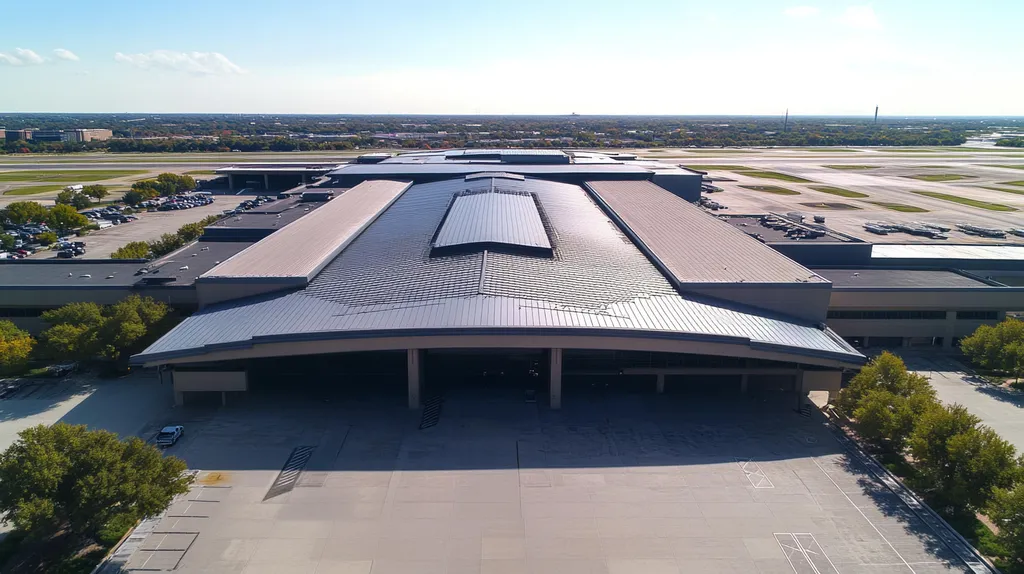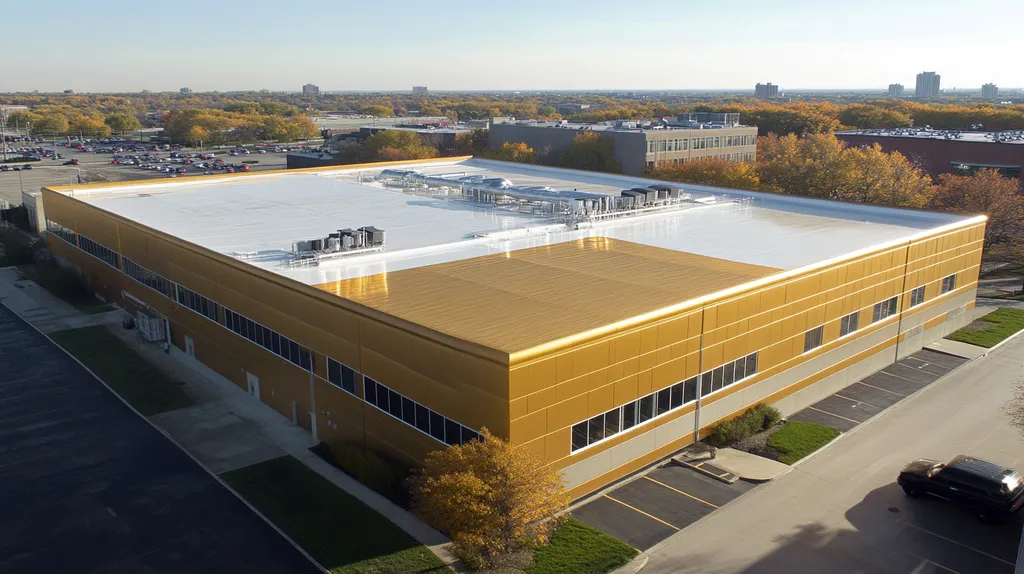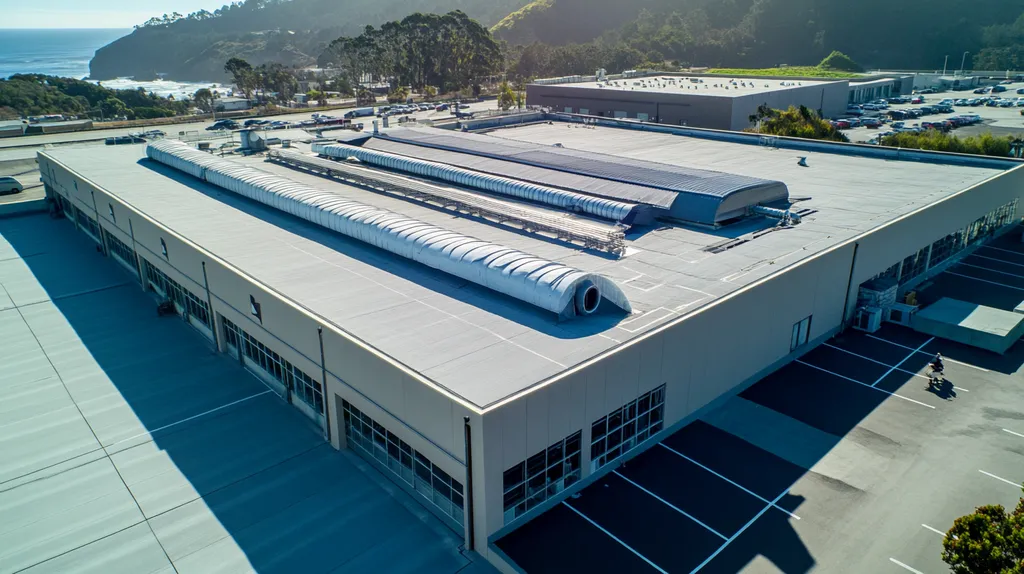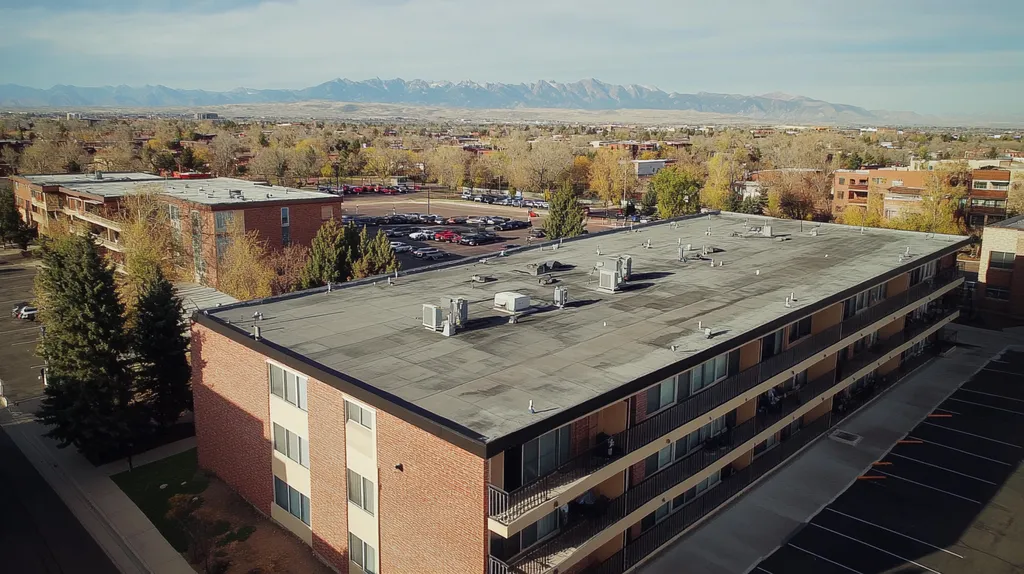Nearly 40% of commercial property managers report that poor roof aesthetics directly impact tenant retention and property values, according to recent industry surveys. Yet many overlook crucial design elements that could enhance their buildings’ visual appeal while maintaining structural integrity.
From innovative materials to architectural features, today’s commercial roofing solutions offer unprecedented opportunities to transform ordinary structures into striking landmarks. However, these aesthetic improvements must carefully balance performance requirements, financial considerations, and regulatory compliance.
This comprehensive guide examines essential design elements that improve commercial roof aesthetics while addressing critical factors like weather resistance, energy efficiency, and long-term maintenance needs.
SECTION 1: PERFORMANCE FACTORS
The design of a commercial roof is vital, impacting not just its visual appeal but also its performance and longevity. Key factors like climate, energy efficiency, and structural integrity heavily influence how well a roof functions and withstands the test of time. Research shows that subpar roofing decisions can escalate operational costs and lead to serious property damage. For property professionals, grasping these performance factors is crucial for improving aesthetics and ensuring reliable functionality.
Climate and Weather Resistance
Climate plays a major role in determining a commercial roof’s lifespan and effectiveness. For properties situated in areas with severe weather patterns, it’s essential to choose roofs that can robustly handle heavy rain, hail, or intense sunlight. By utilizing moisture-resistant materials, property owners can significantly minimize the risk of water leaks, which often initiate costly structural issues.
Weather resistance extends beyond just selecting the right materials; installation techniques are equally important. Effectively sealing joints and employing high-quality adhesives can bolster the roof’s resilience against harsh conditions. Roofs designed to withstand the elements not only enjoy increased longevity but also decrease the chances of unexpected repair expenses.
Additionally, thoughtful roof design can reduce heat absorption. Incorporating reflective materials, for instance, can help maintain cooler temperatures inside commercial buildings, lowering cooling costs and enhancing occupant comfort. Addressing weather resistance proactively is pivotal for the long-term structural integrity of a property.
Key Action Items
Energy Efficiency and Insulation
Energy efficiency has become a cornerstone of modern commercial roofing design. Inadequate insulation can lead to significant heat loss, which inflates heating and cooling costs for property owners. Integrating energy-efficient materials, such as insulated roofing panels, can markedly enhance thermal efficiency.
Research indicates that buildings with improved insulation can reduce energy bills by up to 30%. This financial saving not only benefits the operational budget but also boosts the property’s market value. An energy-efficient roof design fosters a positive image as an eco-friendly facility, appealing to environmentally conscious tenants and customers.
Compliance with local building codes often requires energy-efficient solutions, helping to avoid penalties and enhancing attractiveness in a competitive marketplace. Choosing energy-efficient options like cool roofing systems, which reflect instead of absorb sunlight, can also mitigate urban heat islands while maximizing HVAC performance. Investing in energy efficiency translates to a brighter financial future for the property.
Key Action Items
Structural Integrity and Durability
The structural integrity of a commercial roof is essential for both safety and longevity. Utilizing durable materials such as metal or high-quality single-ply membranes is critical for withstanding diverse load conditions, including foot traffic and environmental factors. Ensuring the roof can handle these stresses is pivotal in preventing premature issues.
Regular maintenance is crucial in preserving structural integrity. Routine inspections enable early detection of potential problems like cracks or wear, allowing for timely repairs. This preventive approach not only extends the lifespan of the roof but further enhances the property’s overall visual appeal.
Durability influences long-term life-cycle costs significantly. A well-constructed roofing system can last two to three decades, distributing initial financial investments over many years. Selecting the optimal combination of materials and design yields considerable benefits for property owners. A well-maintained roof that stands the test of time ensures both aesthetic value and functional resilience.
Key Action Items
SECTION 2: FINANCIAL CONSIDERATIONS
For property owners, grasping the financial implications of enhancing a commercial roof’s aesthetics is vital. Eye-catching design elements not only create strong first impressions but can also elevate overall property value. Studies demonstrate that maintaining an attractive roof can boost property resale value by as much as 15%. Careful evaluation of costs and benefits is essential for making informed decisions.
Initial Investment and Cost-Benefit Analysis
Investing in aesthetic upgrades for a commercial roof necessitates careful financial planning. Key expenses may include premium materials, specialized coatings, and architectural features that enhance visual appeal. Though the upfront costs may seem significant, these enhancements can entice tenants and clients willing to invest more for an appealing environment.
Property professionals should conduct a thorough cost-benefit analysis that reviews both immediate expenses and long-term returns, such as decreased vacancy rates and potential rental income increases. The right investment can significantly enhance profitability.
Collaborating with roofing experts can uncover cost-efficient options that improve appearance without stretching budgets. Prioritizing upgrades in line with the property’s market positioning can maximize return on investment and cultivate higher occupancy rates and tenant retention.
Key Action Items
Maintenance and Repair Costs
Aesthetic upgrades can impact ongoing maintenance and repair expenses. Enhanced roof designs may incorporate specialized materials, potentially leading to higher long-term care costs. Property owners must remain aware of these factors when pursuing aesthetic improvements.
To preserve the roof’s visual appeal, regular maintenance becomes paramount. Unique roofing materials with special colors or textures could require specific cleaning methods, influencing overall upkeep costs. Implementing a proactive maintenance schedule can avert substantial repair costs over time.
Fortunately, selecting high-quality, visually appealing materials may enhance durability, potentially reducing repair frequency. Informed decisions regarding materials can alleviate future maintenance costs, creating a balance between initial expenses and long-term financial health.
Key Action Items
Impact on Property Value and Rent
A visually appealing commercial roof can significantly affect both property value and rental income. Attractive roofing elements often lead to perceptions of higher quality, justifying increased rent prices. Research indicates that well-designed roofs can command rents up to 12% higher than standard options.
Moreover, beautiful roofing systems enhance the brand image for tenants, serving as a major attraction for businesses. This desirability can result in lower vacancy rates, ultimately supporting a healthier financial situation for property managers.
Property appraisers frequently consider visual aesthetics when determining value. A well-crafted roof with striking features can yield favorable appraisals, positively influencing equity. This highlights the financial value of investing in roof aesthetics in the competitive commercial property market.
Key Action Items
SECTION 3: COMPLIANCE REQUIREMENTS
Compliance with building codes and regulations is critical for ensuring the safety and longevity of commercial roofs. Ignoring these requirements can lead to hefty fines, legal complications, and potential structural failures. For instance, the International Building Code (IBC) specifies standards to ensure roofs withstand local environmental challenges. A comprehensive understanding of these codes is essential for property professionals who wish to safeguard their investments.
Building Code and Regulatory Adherence
Building codes dictate various roofing aspects, including the choice of materials, installation techniques, and structural stability. These regulations ensure roofs can handle natural forces such as wind and snow loads. For example, properties in hurricane-prone areas must meet higher wind-resistance standards.
Collaboration with knowledgeable roofing contractors is essential for compliant construction. Skipping these guidelines can lead to severe penalties and compromise tenant safety. Conducting routine inspections can help maintain adherence to these standards over time.
Local zoning laws may further influence roof design. While green roofing systems might be promoted, they must still comply with specific regulations. This underscores the importance of consulting local authorities during the early planning stages.
Key Action Items
Environmental and Sustainability Standards
Meeting environmental standards is becoming increasingly vital in the commercial roofing industry. Standards such as LEED (Leadership in Energy and Environmental Design) promote building practices that minimize ecological impact. Utilizing sustainable materials and energy-efficient designs can also yield valuable tax incentives.
For instance, employing reflective roofing materials can help decrease urban heat islands, lowering overall energy consumption. Enhancing a property’s appeal through compliance opens doors to potential tenants drawn to green-certified buildings.
Energy codes like ASHRAE 90.1 establish fundamental efficiency benchmarks for roofing systems. Owners investing in compliant solutions may benefit from lowered operational expenses and increased tenant satisfaction. Staying informed about evolving sustainability standards is essential for ongoing competitiveness.
Key Action Items
Accessibility and Safety Regulations
Ensuring accessibility and safety in commercial roofing is essential for allowing all individuals to access and navigate buildings effectively. The Americans with Disabilities Act (ADA) sets forth regulations impacting roof access points like hatches and walkways.
To comply with these standards, property owners must integrate accessibility features into their roof designs. Failing to do so can result in legal challenges and negative public perception. It’s crucial to consider potential accessibility needs right from the start of the renovation or construction process.
Safety compliance, particularly regarding worker safety during roofing projects, is equally important. Adhering to OSHA (Occupational Safety and Health Administration) regulations can substantially reduce the risk of workplace accidents. Regular safety audits and training sessions can foster a secure working environment.
Key Action Items
SECTION 4: RISK MANAGEMENT
Risk management is critical in the realm of commercial roofing, serving as a protective barrier against unforeseen challenges that can jeopardize investments and diminish aesthetic appeal. Neglecting potential risks can result in swift escalations of repair costs and a significant decline in property value. Alarmingly, the National Roofing Contractors Association reveals that a staggering 80% of roofing issues stem from drainage problems, underscoring their impact on aesthetics. This section delves into the identification of hazards, management of weather-related risks, and quality assurance for contractors and materials.
Identifying Potential Hazards and Failures
The first step in effective risk management is identifying potential hazards that can compromise a commercial roof’s integrity. Common issues range from leaks and material deterioration to structural weaknesses. If neglected, these problems can lead to water damage, which not only detracts from visual appeal but also fosters mold growth, impacting indoor air quality.
Property owners should conduct routine inspections to detect signs of wear and tear early on. This proactive approach involves checking for cracks, blisters, and excessive granule loss in roofing materials. Timely identification and mitigation of these risks frequently yield substantial savings in repair costs down the line.
Moreover, maintaining open communication channels with roofing professionals ensures timely intervention for any identified hazards. By prioritizing preventative maintenance, property managers can enhance both the longevity and visual appeal of their roofing systems.
Key Action Items
Mitigating Weather-Related Risks
Weather conditions pose significant risks to the integrity of commercial roofs. Extreme temperatures, high winds, and heavy rainfall can quickly compromise both the safety and aesthetics of a roofing system. For instance, hailstorms might cause dents and punctures, while strong winds can detach roofing materials.
Property owners must factor in local climate conditions when selecting roofing materials and designs. Choosing more resilient options can enhance not only durability but also visual appeal. For example, reflective roof coatings not only improve energy efficiency but also contribute positively to the aesthetic look of the building, particularly in warmer climates.
Additionally, installing adequate drainage systems is vital for preventing water-related issues. Without effective drainage, standing water can accumulate, damaging the roof and undermining the building’s curb appeal.
Key Action Items
Ensuring Contractor and Material Quality
The quality of contractors and materials is paramount for minimizing long-term risks associated with commercial roofing. Selecting an experienced roofing contractor is crucial; their expertise directly influences the roof’s performance and longevity. Subpar workmanship can lead to failures that jeopardize both safety and aesthetics.
Choosing high-quality materials that meet industry standards is equally important. Inferior products may result in premature deterioration, negatively impacting both the roof’s appearance and functionality.
Property managers should consistently review contractor performance and material specifications to ensure that high standards are upheld in every roofing project. This vigilance not only preserves aesthetic value but also enhances structural integrity over time.
Key Action Items
SECTION 5: OPERATIONAL PROCEDURES
Operational procedures are critical for ensuring that commercial roofs not only maintain their aesthetic appeal but also function effectively and remain durable over time. Regular inspection and maintenance are key to preventing costly repairs and reinforcing the overall attractiveness of a property. Research indicates that well-maintained roofs can lead to higher property values and increased tenant satisfaction, making efficient operational protocols essential for aligning a roof’s functionality with its visual impact.
Regular Inspection and Maintenance Schedules
Establishing a routine for inspections and maintenance is essential for any commercial roof. Property professionals should perform inspections at least twice a year, optimally in the spring and fall, to catch potential issues early on. Documenting any signs of wear or damage during these inspections allows for timely action, preventing more extensive repairs down the line.
Post-storm assessments are also crucial since weather events can inflict hidden damage that may not be immediately visible. Quick evaluations can help prevent water intrusion and other issues that may compromise the roof’s performance and aesthetics.
Implementing a comprehensive maintenance checklist during these inspections is advantageous. This checklist can evaluate drainage systems, inspect seams, and monitor debris accumulation, enhancing both aesthetic appeal and roofing longevity. Recording inspection findings is vital for future evaluations and to inform maintenance decisions effectively.
Key Action Items
Repair and Replacement Protocols
Clear protocols for repairs and replacements are vital for maintaining a roof’s aesthetic and functional integrity. Timely action is crucial when damage is identified; quick responses can prevent minor issues from escalating. Prioritizing minor repairs, such as fixing membrane punctures or damaged flashing, is essential to keep the roof in optimal condition.
For significant repairs or total roof replacements, professional guidance is indispensable. Collaborating with experienced roofing contractors ensures that materials and practices align not only with aesthetic goals but also with industry standards.
Replacement protocols should include sustainable and visually appealing roofing materials. Solutions like green roofs or reflective coatings can enhance visual appeal while offering environmental benefits. Establishing a timeline for repairs and replacements is essential to minimize disruption and assist with budget planning.
Key Action Items
Training for Facility Maintenance Personnel
Investing in training for facility maintenance personnel is essential for effective roof management. Staff should learn how to identify common roofing issues early, enabling timely interventions that preserve both functionality and aesthetics. Well-trained personnel can carry out regular checks and perform minor repairs, ensuring longevity for the roof.
Effective training programs should cover key topics such as safety protocols, risk assessment, and best maintenance practices. This knowledge empowers staff to maintain the roof and uphold the overall integrity and appearance of the building.
Keeping personnel updated on the latest roofing technologies and materials is also crucial. Ongoing education enables the team to adopt modern solutions that enhance both aesthetics and performance. A culture of maintenance awareness among staff positively impacts roof durability and appearance while reflecting management’s commitment to maintenance.
Key Action Items
SECTION 5: OPERATIONAL PROCEDURES
Operational procedures are vital for ensuring commercial roofs not only retain their visual allure but also function effectively and endure through time. Regular inspections, coupled with proactive maintenance, can significantly mitigate the risk of costly repairs and enhance the property’s overall aesthetic. Research shows that well-managed roofs contribute to higher property values and improved tenant satisfaction, emphasizing the importance of efficient operational protocols that align the functionality of a roof with its visual presence.
Regular Inspection and Maintenance Schedules
Establishing a consistent inspection and maintenance routine is essential for the longevity of any commercial roof. Property professionals should conduct thorough evaluations at least twice a year—preferably in spring and fall—to identify any arising issues. Documenting signs of wear or damage during these inspections allows for prompt action, preventing more extensive repairs in the future.
In addition to these biannual assessments, post-storm evaluations are crucial. Weather events can lead to concealed damage, making quick inspections necessary to avert water infiltration and other concerns that may compromise the roof’s performance and appearance.
Implementing a structured maintenance checklist during these inspections proves beneficial. This can encompass evaluating drainage systems, inspecting seams, and checking for debris accumulation—actions that enhance aesthetics while preserving the functional lifespan of the roof. Keeping detailed records of inspection findings helps inform future maintenance decisions and ensures accountability.
Key Action Items
Repair and Replacement Protocols
Clear protocols for repairs and replacements are critical for maintaining both the aesthetic charm and functional integrity of the roof. Quick action is essential when any damage is detected, as timely interventions can prevent minor issues from escalating. Prioritizing minor repairs, such as fixing membrane punctures or damaged flashing, is crucial to keep the roof in optimal condition.
For significant repairs or total roof replacements, expert guidance is necessary. Collaboration with experienced roofing contractors ensures that chosen materials and practices meet both aesthetic objectives and industry standards, ultimately enhancing the property’s allure.
Replacement protocols should also consider sustainable and aesthetically appealing roofing choices, such as green roofs or reflective coatings, which improve visual appeal and provide environmental advantages. Establishing a clear timeline for repairs and replacements helps minimize disruptions and supports better budget planning, leading to greater tenant satisfaction with the building’s appearance.
Key Action Items
Training for Facility Maintenance Personnel
Investing in training for maintenance personnel is essential for effective roof management and longevity. Staff should be equipped to identify common roofing issues early, enabling prompt interventions that safeguard both functionality and aesthetics. Well-trained personnel can perform regular inspections and minor repairs, contributing significantly to preserving the roof’s integrity.
Effective training programs should cover critical topics like safety protocols, risk assessment, and best maintenance practices. This knowledge empowers staff to manage the roof and maintain the overall appearance of the entire building.
Keeping personnel informed on new roofing technologies and materials is also crucial. As the industry evolves, continual education equips the team to implement modern solutions that enhance both aesthetics and performance. Cultivating a maintenance-aware culture among staff strengthens both the roof’s durability and overall property appeal, reflecting management’s commitment to facility upkeep.
Key Action Items
Moving Forward
With 40% of commercial property managers reporting direct revenue impacts from poor roof aesthetics, the stakes for enhancing commercial roof design have never been higher.
The integration of performance factors, financial considerations, and compliance requirements creates a framework for achieving both visual appeal and structural integrity.
Risk management strategies and operational procedures provide the foundation for maintaining these improvements over time, while proper material selection ensures lasting aesthetic value.
As sustainability standards evolve and tenant expectations rise, property professionals who implement these design elements position themselves at the forefront of the market, potentially increasing property values by up to 15%.
The future of commercial roofing lies in this balanced approach to aesthetics and functionality, making immediate action essential for maintaining competitive advantage.
FREQUENTLY ASKED QUESTIONS
Q. How do performance factors affect commercial roofs?
A. Performance factors, including climate, energy efficiency, and structural integrity, influence a roof’s lifespan. Selecting appropriate materials and installation techniques can prevent costly repairs and enhance aesthetics. Addressing these factors ensures long-term reliability for property owners.
Q. What are the financial benefits of a well-designed commercial roof?
A. A visually appealing roof can elevate property value and attract tenants, potentially increasing rental rates. Conducting a cost-benefit analysis helps property owners understand potential returns on investments in roof aesthetics.
Q. What compliance issues should I consider for my commercial roof?
A. Compliance with building codes and local regulations is crucial for safety and longevity. Understanding environmental standards and accessibility requirements helps avoid fines and legal challenges while preserving roof integrity.
Q. How can I manage risks associated with commercial roofs?
A. Identifying hazards and mitigating weather-related risks significantly reduces repair costs. Routine inspections and proper drainage systems are essential strategies to maintain both the roof’s functionality and visual appeal.
Q. What operational procedures ensure the integrity of my commercial roof?
A. Regular inspections, timely repairs, and maintenance protocols are critical for preserving roof functionality. Training maintenance personnel in identifying issues early significantly impacts long-term durability and aesthetics.
Q. How does roof design impact tenant satisfaction?
A. An aesthetically pleasing roof creates a positive impression and enhances tenant experience. Attractive roofs can reduce vacancy rates and support higher rental income, reinforcing the importance of design in tenant satisfaction.
Q. What role does sustainability play in commercial roofing?
A. Sustainability in roofing not only benefits the environment but also attracts eco-conscious tenants. Implementing energy-efficient materials and green roofing can lead to cost savings and enhanced property appeal, paving the way for future opportunities.











